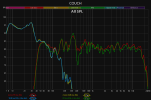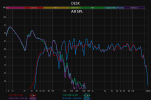TurtlePaul
Addicted to Fun and Learning
It is most likely microphone alignment. The reason summed left and right response is not used for high frequency is because the wavelengths get too short. 4 khz has a wavelength at of about 3.4 inches. If his microphone is a mere 1.7 inches closer to one speaker than the other then it will measure a textbook cancelation notch at 4 khz (as we can see).I don't know, but if your speakers cross over to the tweeters between 3K and 7K could just one tweeter be wired with the wrong polarity? Probably just the right one? As I said, I'm stumped, but might it be worth reversing the wires to the right tweeter only, just to see?
As far as audibility is concerned, I'd bet that, at that frequency, the dip would be audible on some music.
Fortunately our head has two ears which are spaced apart so the sound waves reach our ears at different times and we get different nulls. There is a big round thing between our ears that shields each ear from cross cancelation from the opposite direction. All this means that instead of hearing nulls our brain is able to interpret this as soundstage and directional audio.



